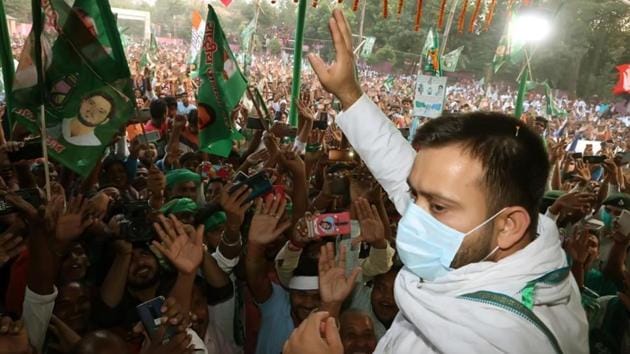Where Tejashwi Yadav slips behind the NDA
The sooner Yadav learns the lesson that campaigns have to be dynamic, the more chances he will have of posing a serious challenge to the NDA
A fortnight ago, most political analysts were convinced about the return of the Nitish Kumar-led National Democratic Alliance (NDA) government to power in Bihar. However, the unexpectedly large turnout at the Rashtriya Janata Dal (RJD) leader Tejashwi Yadav’s rallies has lent a new dimension. While there are many factors which influence voters, the role of the campaign is important in swaying undecided voters.

Although the Covid-19 pandemic has limited physical campaigning, it has not been replaced. Instead, it has been supplemented by new modes of campaigning. Political parties have designed digital campaigns to reach the maximum number of voters. Our study shows that all major political parties in Bihar — the Bharatiya Janata Party (BJP), the Congress, and the Janata Dal (United) or JD(U) — have advertised heavily on social media. While the RJD has not done so officially, some of its leaders such as Madhu Singh, Parwez Alam, Nand Kumar Rai have been actively campaigning on these platforms. Tejashwi Yadav has been posting videos and messages on his public social media pages, but has not bought any campaign ads to promote these messages.
While the RJD’s decision to focus on ground-level campaigns may have been driven by the fact that most of its voters are not online — and in order to utilise limited resources effectively — this strategy could have a negative impact on its overall vote-share. Our pre-poll survey (n=2497) conducted by IPSOS, a market research company, from September 26 to October 10 shows that 26.5% of internet users intend to vote for the RJD, second only to the BJP, which attracts 43.2% of internet users as potential voters. And 15.5% of internet users were undecided at the beginning of the campaign. The survey also shows that over 19% of voters, overall, were undecided at the beginning of the campaign.
Anecdotal evidence suggests that Tejashwi Yadav is being able to leverage the anti-incumbency sentiment, though most opinion polls predict a comfortable win for the Nitish Kumar-led NDA. Yadav is focusing on young voters and has promised that, if elected, his government will provide one million government jobs to young people. Yet, there is a paradox in his campaign strategy. Social media is the most popular medium among young citizens. Yet, the RJD has not invested in this medium. Given the fact that campaigns require a dynamic approach to influence voters, and need to evolve continuously, no medium, howsoever small, can be ignored. The unexpected turnout at his rallies should have made Yadav change his campaign strategy and start focusing on social media in addition to canvassing at the grassroots to appeal to the youth. This would have helped create a bandwagon effect as voters are more likely to move towards a party that is seen as being ahead in the race.

At the moment, the NDA has an advantage in terms of the sheer volume of face-to-face contact, virtual rallies, posters, social media reach, news coverage and the presence of star campaigners, including Prime Minister (PM) Narendra Modi. The network effects generated from contacts on multiple platforms could play a significant part in persuading potential voters. Voter turn-out will be a major factor, especially if NDA supporters are not too enthused about their chief ministerial candidate — Nitish Kumar, as many opinion polls suggest. The BJP has created confusion among its voters by not unequivocally opposing the Lok Janshakti Party (LJP) Chirag Paswan’s attacks on Nitish Kumar. This could well demobilise its voters. But the new campaign strategy to counter Yadav’s rising popularity by organising many rallies of the PM shows that the central leadership can come together quickly, and work effectively, to steer the campaign in the right direction.
The ball is now in the RJD’s court to counter the BJP’s reinforcements in the last tranches of the campaign. If the RJD speaks about issues that concern voters and stays on message, there is much to gain. While the past baggage associated with the RJD — of being an enabler of a jungle raj — could affect the overall chances of the RJD-led alliance securing a majority, it should be noted here that young voters aren’t interested in past issues.
While his social base among the Yadavs remains intact, by focusing on young voters, Tejashwi Yadav is trying to diversify his social constituencies. Grassroots engagement is important for political parties but elections are no longer won by ground-level campaigning alone.
The sooner Yadav learns the lesson that campaigns have to be dynamic, the more chances he will have of posing a serious challenge to the NDA.



